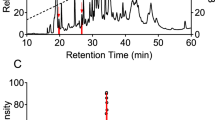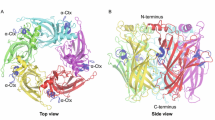Abstract
Characteristics of specific125I-omega-conotoxin (ω-CgTX) binding were systematically investigated in crude membranes from rat whole brain. Kd and Bmax Values for the binding were 49.7 pM and 181.5 fmol/mg of protein, respectively. The effects of various types of Ca channel antagonists on the binding were investigated. Dynorphin A (1–13), in particular, specifically inhibited125I-ω-CgTX binding, but not that of [3H](+)PN200-110. Spider venom fromPlectreurys tristes did not specifically inhibit specific binding of125I-ω-CgTX, because the venom also inhibited the binding of [3H](+)PN200-110 to a similar degree. The amount of specific binding of125I-ω-CgTX was less in the cerebellum than that in any other area of whole brain. The cross-linker disuccinimidyl suberate did not label with125I-ω-CgTX and its binding sites in rat whole brain, although it did in chick whole brain, which was used as a positive control. These findings suggested that dynorphine A (1–13) was a selective blocker of ω-CgTX-sensitive Ca channels in crude membranes from rat whole brain and that ω-CgTX-sensitive Ca channels were mainly present a rat brain except cerebellum.
Similar content being viewed by others
References
Greenberg, D. A. 1987. Calcium channels and calcium channel antagonists. Ann. Neurol. 21:317–330.
Reuter, H. 1983. Calcium channel modulation by neurotransmitters, enzymes, and drugs. Nature 301:569–574.
Tsien, R. W. 1983. Calcium channels in excitable cell membranes. Annu. Rev. Physiol. 45:341–358.
Nowycky, M. C., Fox, A. P., and Tsien, R. W. 1985. Three types of neuronal calcium channel with different calcium agonist sensitivity. Nature 316:440–443.
Olivera, B. M., McIntosh, J. M., Cruz, L.-J., Luque, F. A., and Gray, W. R. 1984. Purification and sequence of a presynaptic peptide toxin fromConus geographus venom. Biochemistry 23:5087–5090.
Kasai, H., Aosaki, T., and Fukuda, J. 1987. Presynaptic Caantagonist ω-conotoxin irreversibly blocks N-type Ca-channels in chick sensory neurons. Neurosci. Res. 4:228–235.
Kerr, L. M., and Yoshikami, D. 1984. A venom peptide with a novel presynaptic blocking action. Nature 308:282–284.
Koyano, K., Abe, T., Nishiuti, Y., and Sakakibara, S. 1987. Effects of synthetic ω-conotoxin on synaptic transmission. Eur. J. Pharmacol. 135:337–343.
McCleskey, E. W., Fox, A. P., Feldman, D. H., Cruz, L. J., Olivera, B. M., Tsien, R. W., and Yoshikami, D. 1987. ω-conotoxin: direct and persistent blockade of specific types of calcium channels in neurons but not muscle. Proc. Natl. Acad. Sci. U.S.A. 84:4327–4331.
Oyama, Y., Tsuda, Y., Sakakibara, S., and Akaike, N. 1987. Synthetic ω-conotoxin: potent calcium channel blocking neurotoxin. Brain Res. 424:58–64.
Enomoto, K., Sano, K., Shibuya, Y., and Maeno, T. 1986. Blockade of transmitter release by a synthetic venom peptide, ω-CgTX. Proc. Jpn Acad. Ser.B. Phys. Biol. Sci. 62:267–270.
Reynolds, I. J., Wagner, J. B., Snyder, S. H., Thayer, S. A., Olivera, B. M., and Miller, R. J. 1986. Brain voltage-sensitive calcium channel subtypes differentiated by ω-conotoxin fraction GVIA. Proc. Natl. Acad. Sci. U.S.A. 83:8804–8807.
McCleskey, E. W., Fox, A. P., Feldman, D., and Tsien, R. W. 1986. Different types of calcium channels. J. Exp. Biol. 124:177–190.
Cruz, L. J., and Olivera, B. M. 1986. Calcium channel antagonists: ω-conotoxin defines a new high affinity site. J. Biol. Chem. 261:6230–6233.
Abe, T., Koyano, K., Saitsu, H., Nishiuchi, Y., and Sakakibara, S. 1986. Binding of ω-conotoxin to receptor sites associated with the voltage-sensitive calcium channel. Neurosci. Lett. 71:203–208.
Knaus, H-G., Striessnig, J., Koza, A., and Glossmann, H. 1987. Neurotoxic aminoglycoside antibiotics are potent inhibitors of [125I]-omega-conotoxin GVIA binding to guinea-pig cerebral cortex membranes. Naunyn-Schmied. Arch Pharmacol. 336:583–586.
Feigenbaum, P., Garcia, M. L., and Kaczorowski, G. J. 1988. Evidence for distinct sites coupled to high affinity ω-conotoxin receptors in rat brain synaptic plasma membrane vesicles. Biochem. Biophys. Res. Commun. 154:298–305.
Ichida, S., Fujisue, T., Masada, A., Oda, Y., Matsuda, N., and Aonuma, S. 1989a. Characteristics of specific bindings of nitrendine and PN200-110 to various crude membranes: Induction of irreversible bindings by UV irradiation. J. Biochem. 105:760–766.
Ichida, S., Masada, A., Fujisue, T., Yoshioka, T., and Matsuda, N. 1989b. Photoaffinity labeling with dihydropyridine derivatives of crude membranes from rat skeletal, cardiac, ileal, and uterine muscles and whole brain. J. Biochem. 105:767–774.
Benovic, J. L., Strasser, R. H., Caron, M. G., and Lefkowitz, R. J. 1986. β-Adrenergic receptor kinase: Identification of a novel protein kinase that phosphorylates the agonist-occupied form of the receptor. Proc. Natl. Acad. Sci. U.S.A. 83:2797–2801.
Nelder, J. A., and Nead, R. 1965. A simplex method for function minimization. Computer J. 7:308–313.
Barhanin, J., Schmid, A., and Lazdunski, M. 1988. Properties of structure and interaction of the receptor for ω-CgTX, a polypeptide active on Ca2+ channels. Biochem. Biophys. Res. Commun. 105:1051–1062.
Laemmli, U. K. 1970. Cleavage of structural proteins during the assembly of the head of bacteriophage T4. Nature 227:680–685.
Glowinski, J., and Iversen, L. L. 1966. Regional studies of catecholamines in the rat brain-I. The disposition of [3H]norepinephrine, [3H]dopamine and [3H]dopa in various regions of the brain. J. Neurochem. 13:665–669.
Gray, E. F., and Whittaker, V. P. 1962. The isolation of nerve ending from brain: an electron microscopic study of cell fragments derived by homogenization and centrifugation. J. Anat. (Lond.) 96:79–88.
Ichida, S., Yonehara, N., Watanabe, Y., and Yoshida, H. 1980. Inhibitory effect of dibutyryl cyclic GMP on potassium-stimulated45Ca uptake by synaptosomes from rat brain. Brain Res. 192:487–494.
Lowry, O. H., Rosebrough, N. J., Farr, A. L., and Randall, R. J. 1951. Protein measurement with the folin phenol reagent. J. Biol. Chem. 193:265–275.
Marqueze, B., Martin-Moutot, N., Leveque, C., and Couraud, F. 1988. Characterization of the ς-conotoxin-binding molecule in rat brain synaptosomes and cultured neurons. Mol. Pharmacol. 34:87–90.
Gross, R. A., and MacDonald, R. L. 1987. Dynorphin A selectively reduces a large transient (N-type) calcium current of mouse dorsal root ganglion neurons in cell culture. Proc. Natl. Acad. Sci. U.S.A. 84:5469–5473.
Stevens, C. W., Weigner, M. B., and Yaksh, T. L. 1987. Intrathecal dynorphins suppress hindlimb electromyographic activity in rats. Eur. J. Pharmacol. 138:299–302.
Walker, J. M., Moises, H. C., Coy, D. H., Baldrighi, G., and Akil, H. 1982. Nonopiate effects of dynorphin and des-Tyr-dynorphin. Science 218:1136–1138.
Mori, Y., Friedrich, T., Kim, M-S., Mikami, A., Nakai, J., Ruth, P., Boose, E., Hofmann, F., Floxkerzi, V., Furuichi, T., Mikoshiba, K., Imoto, K., Tanabe, T., and Numa, S. 1991. Primary structure and functional expression from complementary DNA of a brain calcium channel. Nature 350:398–402.
DeRiemer, S. A., Strong, J. A., Albert, K. A., Greengard, P., and Kaczmarek, L. K. 1985. Enhancement of calcium current inAplysia neurones by phorbol ester and protein kinase C. Nature 313:313–316.
Hartzell, H. C., and Fischmeister, R. 1986. Opposite effects of cyclic GMP and cyclic AMP on Ca2+ current in single heart cells. Nature 323:273–275.
Levitan, I. B. 1985. Phosphorylation of ion channels. J. Memb. Biol. 87:177–190.
Paupardin-Tritsch, D., Hammond, C., Gerschenfeld, H. M., Nairn, A. C., and Greengard, P. 1986. cGMP-dependent protein kinase enhances Ca2+ current and potentiates the serotonin-induced Ca2+ current increase in snail neurones. Nature 323:812–814.
Schmid, A., Renaud, J., and Lazdunski, M. 1985. Short term and long term effects of β-adrenergic effectors and cyclic AMP on nitrendipine-sensitive voltage-dependent Ca2+ channels of skeletal muscle. J. Biol. Chem. 260:13041–13046.
Sperelakis, N. 1984. Hormonal and neurotransmitter regulation of Ca++ influx through voltage-dependent slow channels in cardiac muscle membrane. Membrane Biochem. 5:131–166.
Strong, J. A., Fox, A. P., Tsien, R. W., and Kaczmarek, L. K. 1987. Stimulation of protein kinase C recruits convert calcium channels inAplysia bag cell neurons. Nature 325:714–717.
Holtz, G. G., Rane, S. G., and Dunlap, K. 1986. GTP-binding proteins mediate transmitter inhibition of voltage-dependent calcium channels. Nature 319:670–672.
Lewis, D. L., Weight, F. F., and Luini, A. 1986. A guanine nucleotide-binding protein mediates the inhibition of voltage-dependent calcium current by somatostatin in a pituitary cell line. Proc. Natl. Acad. Sci. U.S.A. 83:9035–9039.
Pace, U., and Lancet, D. 1986. Olfactory GTP-binding protein: Signal-transducing polypeptide of vertebrate chemosensory neurons. Proc. Natl. Acad. Sci. U.S.A. 83:4947–4951.
Scott, R. H., and Dolphin, A. C. 1986. Regulation of calcium currents by a GTP analogue: Potentiation of (−)-baclofen-mediated inhibition. Neurosci. Lett. 69:59–64.
Ahlijanian, M. K., Striessnig, J., and Catterall, W. A. 1991. Phosphorylation of an α1-like subunit of an ω-conotoxin-sensitive brain calcium channel by cAMP-dependent protein kinase and protein kinase C. J. Biol. Chem. 266:20192–20197.
Abe, T., and Saitsu, H. 1986. Photoaffinity labeling of the receptor for ω-conotoxin. Proc. Jpn. Acad. Ser. B. Phys. Biol. Sci. 62:416–418.
Crutz, L. J., Johnson, D. S., and Olivera, B. M. 1987. Characterization of the ω-conotoxin target. Evidence for tissue-specific heterogeneity in calcium channel types. Biochemistry 26:820–824.
Author information
Authors and Affiliations
Rights and permissions
About this article
Cite this article
Ichida, S., Wada, T., Sekiguchi, M. et al. Characteristics of specific125I-ω-conotoxin GVIA binding in rat whole brain. Neurochem Res 18, 1137–1144 (1993). https://doi.org/10.1007/BF00978364
Accepted:
Issue Date:
DOI: https://doi.org/10.1007/BF00978364




